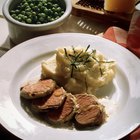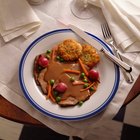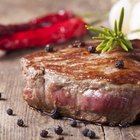
Tender, succulent and savory, prime rib is one of the very best cuts of meat on the market and is often the most expensive item on steakhouse menus. Recreating this fine dining entree is quite simple, requiring only a few ingredients. For best results, start with a USDA Prime grade prime rib. The name of the cut doesn’t imply its grade from the USDA, just that it’s the most desirable cut. The highest quality prime rib will yield the melt-in-your-mouth results seen in fine steakhouses. After hours of slow cooking and basting, your fine prime rib will be absolutely mouthwatering.
Step 1
Select a prime rib cut that has plenty of marbling. USDA Prime prime rib is best if you can get it. If not, look for prime rib with thin layers of fat distributed throughout the cut. The fat will appear white or light pink.
Step 2
Allow the prime rib to come to room temperature while preheating your oven to 450 degrees Fahrenheit. Beef should always be placed in the oven when at room temperature to keep from shocking it -- and causing it to toughen up -- when exposing it to heat.
Step 3
Use a knife to cut 1/2-inch slits on all sides of the meat. Rub butter on all surfaces of the prime rib. Coat the meat on all sides with a spice rub of your choice. Avoid using salt on the prime rib as it can pull moisture out of the meat.
Step 4
Start by cooking the prime rib at 450 degrees for the first 15 minutes. This quickly cooks the outside of the prime rib, sealing the meat and protecting the juicy center.
Step 5
Turn the oven down to 325 degrees for the remainder of the cooking time, basting the prime rib with its own juices every 30 minutes. The slow cooking will create a juicy, tender prime rib. Basting the meat will keep the outside moist.
Step 6
Do not overcook the prime rib. Once an internal temperature of 120 degrees is reached, remove it from the oven.
Step 7
Cover the prime rib with foil for 30 minutes. The meat will continue to cook, reaching a temperature of between 125 and 130 degrees for rare.
Related Articles

How to Slow-Cook Meat in the Oven

How to Cook Marinated Pork Loin From a ...

How to Grill a Ribeye on a Weber Q

How to Cook Tender Rolled Flank Steaks ...

How to Cook a 15-Pound Rib Roast

The Best Way to Prepare Bison Sirloin

How to Cook a Standing Rib With the ...

How to Cook Deer Steaks in the Oven on ...

How to Barbecue Bologna on a Charcoal ...

How to Prepare Chuck Tender Roast

How to Cook a Rib Eye to Medium-Well in ...

How to Cook Antelope

How to Convection Roast a Brisket

How to Pan Cook a Sirloin to Medium-Well

How to Cook a Thresher Shark Steak

How to Cook a Choice New York Roast

How to Make Beef Sirloin Tender

How to Broil Filet Mignon Wrapped in ...
How to Cook Boneless Top Chuck Steak in ...

How to Grill Ribs on a Charcoal Grill
References
Resources
Tips
- Each rib serves two people, so a three rib section will feed about six people.
- Serve alongside au jus, which means “with juice,” by reserving the pan drippings and serving them with the prime rib for dipping.
Warnings
- Improper handling of raw meat can lead to foodborne illnesses. Thoroughly wash your hands and sterilize work surfaces after handling raw meat.
- The safe minimum internal temperature for beef is 140 degrees Fahrenheit. Consuming beef that has not reached 140 degrees may put you at risk for foodborne illnesses.
Writer Bio
Meg Winkler began professionally writing in 2008. She has covered a variety of topics including fine wine, interiors, the arts, lifestyle and history. Winkler has been a luxury publications editor and music critic. She is an independent author and holds a Master of Arts from American Military University.
Photo Credits
Jupiterimages/Stockbyte/Getty Images